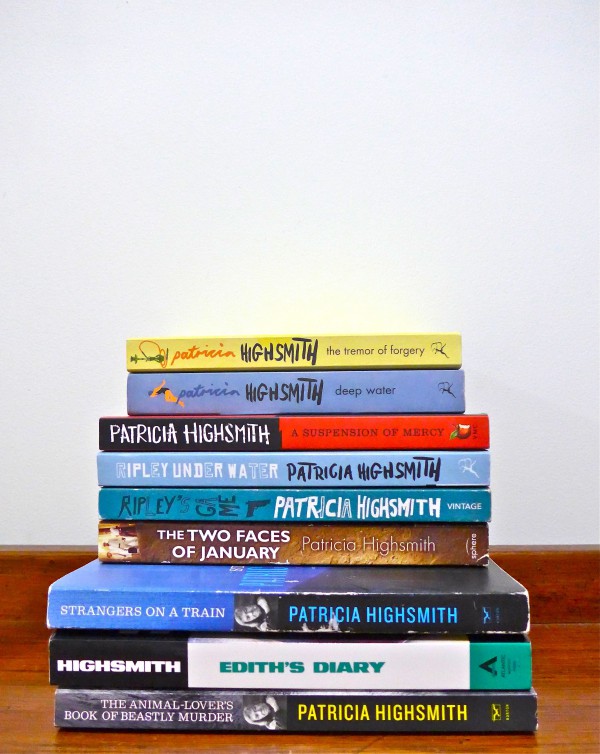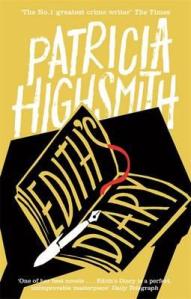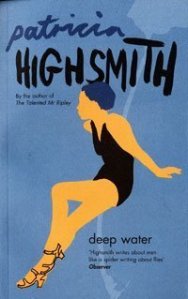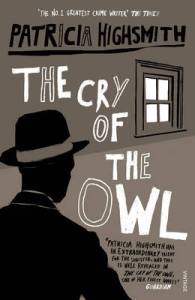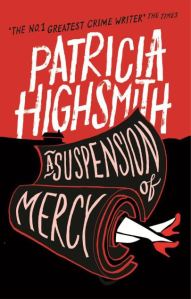Margot McGovern asks why readers can’t get enough of Patricia Highsmith’s sinister style of crime.
Highsmith is the queen of suspense and one of the great crime writers of the twentieth-century. She’s also one of my favourite authors, and when fellow reviewer Melanie Page from Grab the Lapels asked me to recommend my favourite Highsmith novels, I saw an opportunity to get my nerd on.
Who is Highsmith?
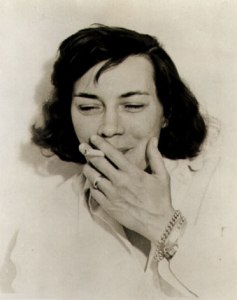
Patricia Highsmith was born in 1921 in Fort Worth, Texas. She spent much of her childhood and adolescence in New York and, after graduating from Barnard College, she wrote comic books by day and worked on her own stories by night. Her first novel, Strangers on a Train was published in 1950 and adapted for the screen by Alfred Hitchcock in 1951. When her writing career began to take off, she relocated to Europe and spent the majority of her remaining years there until her death in 1995.
Highsmith soon developed a reputation for writing tense, psychological thrillers from the point of view of what she termed ‘hero-criminals’. She authored twenty-two novels, several of which have been adapted for the stage and screen, as well as a number of short story collections, though she is perhaps most famous for ‘The Ripliad’, a series of five novels about Tom Ripley, a charming sociopath with a talent for mimicry and murder.
Higsmith had affairs with both men and women, and while she was notoriously difficult to live with and rarely kept her lovers for long, her second novel The Price of Salt (also published as Carol) (1952) is widely considered the first lesbian novel with a happy ending, and homosexuality is a strong theme throughout her work.
Her stories are sinister. Rather than beginning with a body and working towards the restoration of order, her novels start with quaint, idyllic scenarios—seemingly happy young families, couples on holiday, bright young characters with the world at their feet—and map a sharp descent into chaos, each misstep snowballing so that small misunderstandings lead to multiple murders, and innocent games turn deadly.
Her hero-criminals are drawn from the society’s underbelly: stalkers, peeping toms, sociopaths. If a character starts out scrupulous, you can almost guarantee he (and it is usually he) won’t remain so for long, with Highsmith piling on the pressure until he breaks. In a Highsmith novel everyone has a dark side and no one makes it out without a little blood on their hands.
Her plots alone are genius, but it’s Highsmith’s particular air of detachment and almost clinical prose that really gets under the skin. While her plots favour excess, she’s a perfectionist and an aesthete with mid-twentieth century tastes, and there’s no room for florid phrasing or purple prose in her stories. Even at the height of catastrophe, her tone remains calm, and while she often favours exotic locations, her focus zeroes in on the domestic: collecting mail, organising train tickets, preparing drinks for cocktail hour. Yet between these bits of mundane business are shocking acts of violence, paranoia and psychological turmoil. Highsmith narrates them all with the methodical detachment of a sociopath: preparing a cup of coffee or lighting a cigarette takes on the same emotive weight as disposing of a body.
 As her fiction suggests, Highsmith herself was an intriguing and unnerving figure. If you’re curious to know more, I highly recommend Joan Schenkar’s The Talented Miss Highsmith: The Secret Life and Serious Art of Patricia Highsmith (2010), a hefty and thorough biography.
As her fiction suggests, Highsmith herself was an intriguing and unnerving figure. If you’re curious to know more, I highly recommend Joan Schenkar’s The Talented Miss Highsmith: The Secret Life and Serious Art of Patricia Highsmith (2010), a hefty and thorough biography.
The Talented Miss Highsmith is available through Amazon (Kindle), Book Depository and Kobo.
If you’re new to Highsmith, or keen for more, the following are essential reading:
Strangers On A Train (1950)
 Two men meet on a train. One, Guy Haines, is a promising young architect with the world at his feet, the other, Charles Anthony Bruno, is a deviant with money to burn. Each has a problem, someone in their life whom they need to get rid of. Bruno suggests they swap murders and Haines is reluctant to take him seriously until it’s too late.
Two men meet on a train. One, Guy Haines, is a promising young architect with the world at his feet, the other, Charles Anthony Bruno, is a deviant with money to burn. Each has a problem, someone in their life whom they need to get rid of. Bruno suggests they swap murders and Haines is reluctant to take him seriously until it’s too late.
Highsmith’s chilling debut proves that, when pushed, even the most moral among us is capable of murder.
Available:
The Talented Mr. Ripley (1955)
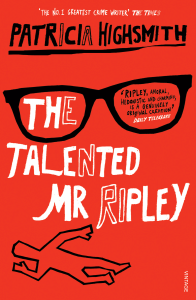 A personal favourite, The Talented Mr. Ripley is the first of the famed ‘Ripliad’ and relates Ripley’s early crimes.
A personal favourite, The Talented Mr. Ripley is the first of the famed ‘Ripliad’ and relates Ripley’s early crimes.
As a young man with little money and expensive tastes living in New York, Ripley talks his way into a free trip to Europe, ostensibly to bring home Dickie Greenleaf, the playboy son of a shipping magnate. However, when Ripley meets up with Dickie in Italy, he soon becomes enamoured of the life Dickie leads and, betrayed by Dickie, conspires to make it his own.
Available:
The Price of Salt (also published as Carol) (1952)
Therese is a lonely young woman living in New York where she’s dating a man she doesn’t love and working at a department store while waiting for her set design career to take off. Just before Christmas she serves a beautiful woman, Carol, who is going through a rough separation with her husband.
The two women strike up a friendship that soon turns into something more. However, Carol’s husband has set a private detective onto the women to gather evidence against Carol to use in their divorce and gain custody of their daughter.
Available:
Edith’s Diary (1977)
Edith’s life is falling apart. Her husband has thrown her over for a younger woman, leaving her to care for their alcoholic son and his ailing uncle. However, the story she records in her diary is far brighter, and little by little, it’s this other, happier tale begins to eclipse the truth.
Available:
Deep Water (1957)
Vic Van Allen seemingly has it all. Independently wealthy, he runs a boutique printing press and is a popular and respected member of the Little Wesley township. He has a fine house, a young daughter he dotes on and a beautiful, charming wife. However, in recent years his wife’s interest has begun to wander. When she begins to take lovers—all younger, attractive men—Vic turns a blind eye. However, she grows increasingly bold, parading her beaus at parties and balls for all the town to see. When Vic learns one of her past lovers has died under mysterious circumstances, he begins a rumour that he killed the man to scare off other suitors. But what starts as a joke soon turns serious, and Vic begins to wonder what it would take to get away with murder.
Available:
The Cry of the Owl (1962)
Following a messy divorce Robert Forester becomes obsessed with twenty-three-year-old Jenny. He begins going to her house in the evenings to watch her through her kitchen window. Shockingly, she catches him and invites him in. However, Jenny isn’t as happy and carefree as she seems, and her fiance is none too pleased when she throws him over for Robert.
Available:
A Suspension of Mercy (1965)
Frustrated TV writer, Sydney Bartleby, is having trouble selling his scripts. When his wife leaves on extended vacation after a fight, Sydney decides to show the world just how good at plotting he is, by fabricating her murder. However, when no one is able to track down his wife, Sydney’s little game becomes a very real nightmare.
Available:
Plotting and Writing Suspense Fiction (1966)
For all the aspiring suspense writers out there, Highsmith wrote this handy book of tips, in which she speaks at length about her process and offers plenty of practical advice from what makes an amoral hero-criminal compelling to how to plot a murder.
I’m generally skeptical of ‘how to write’ books, but Plotting and Writing Suspense Fiction is one of the good ones.
Available:
Like what you see? Keep in touch:
 |
 |
 |
 |
And get the latest from Lectito delivered to your inbox.

